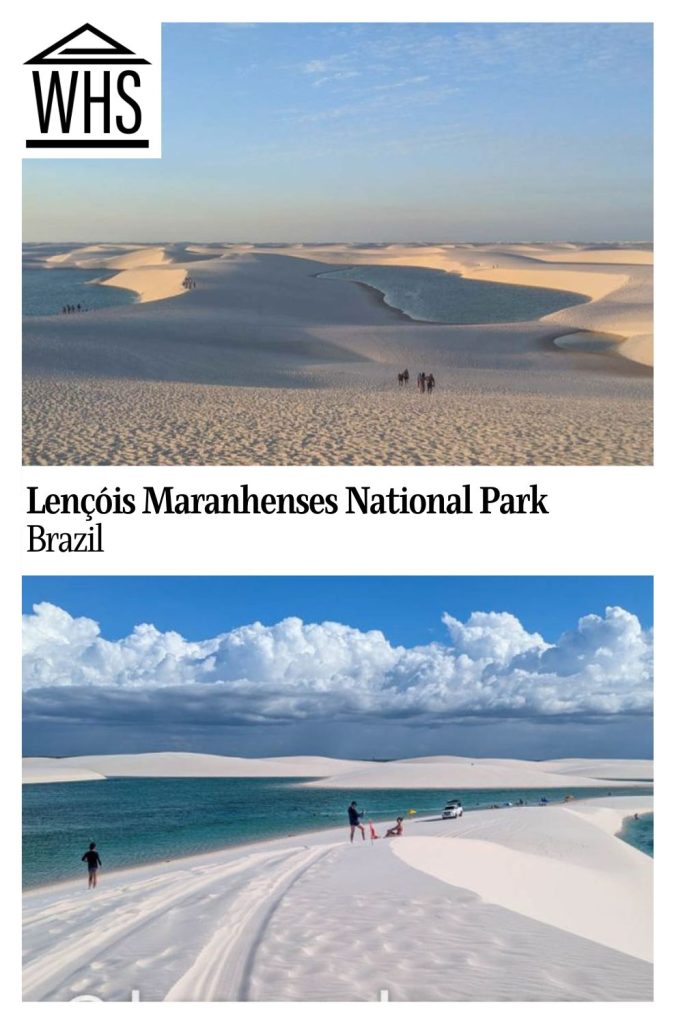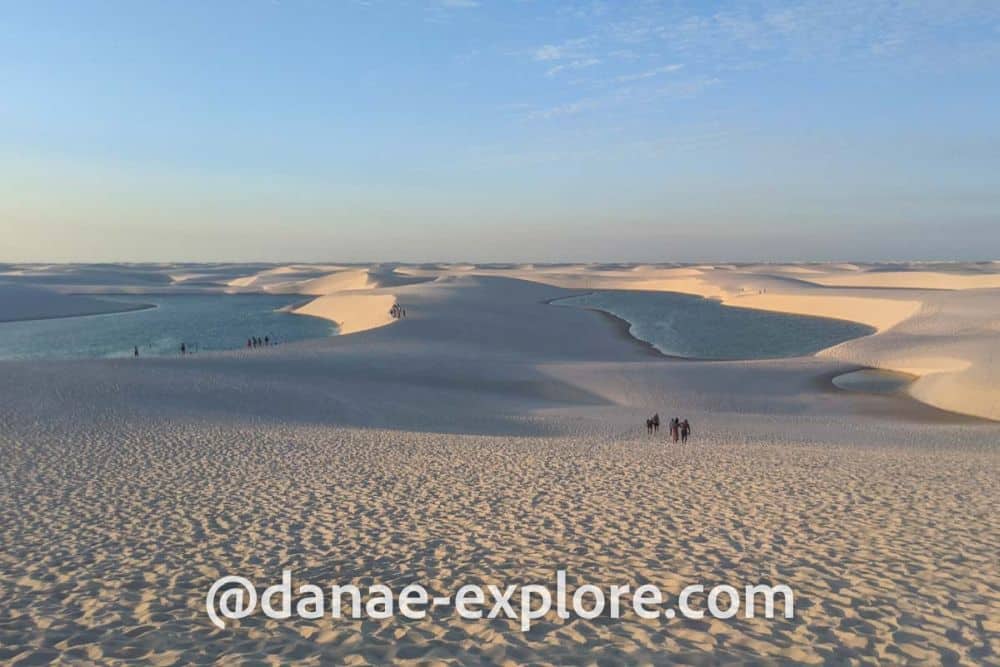Lençóis Maranhenses National Park
By Danae Bianco
What is the Lençóis Maranhenses National Park?
Picture vast, wind-sculpted white sand dunes stretching as far as the eye can see. Nestled between these dunes are crystal-clear lagoons, their waters shimmering in shades of blue and green. The contrast is striking, inviting you to take a dip and soak in the warmth and energy that define Brazil.
Disclosure: This article contains affiliate links. Making a purchase through an affiliate link will mean a small commission for this website. This will not affect your price. Privacy policy.

Seeing these lagoons for the first time is an experience you’ll never forget. The way the dunes and lagoons interact creates a breathtaking scene, one that stays with you long after you’ve left. That’s exactly how I felt when I first explored Lençóis Maranhenses.
Extending along an 80-kilometer-long coastline, the sand on the beach gets blown by wind into small dunes near the beach, progressing to much larger ones further inland. They shift and change yearly. In the rainy season, ponds and lakes form between them, different in shape and location every year, and disappear in the dry season.
Why is Lençóis Maranhenses a UNESCO World Heritage site?
Lençóis Maranhenses National Park was awarded UNESCO World Heritage status for its natural uniqueness, both in terms of its biodiversity and its stunning geological features. The blend of vast white dunes and temporary or permanent lagoons forms a rare landscape, especially during the rainy season when the lagoons fill with water, reflecting dazzling shades of blue and green. It’s a one-of-a-kind, ever-changing beauty that you won’t find anywhere else in the world.

Besides the beauty of these ever-changing dunes and lakes, they are geologically important. According to UNESCO, it is “one of the best and largest examples of the development of coastal dunes.” They “serve as remarkable evidence of the evolutionary progression of coastal dunes over millennia.”
What can you expect from a visit to Lençóis Maranhenses?
You can expect nothing less than the adventure of a lifetime.
Lençóis Maranhenses is my favorite travel destination in Brazil. And I say this as a Brazilian who has traveled extensively across the country, from the Amazon Rainforest to Foz do Iguaçu and the Pantanal.
The combination of stunning landscapes, crystal-clear freshwater lagoons at the perfect temperature, endless sunshine, and the absence of heavy tourism makes Lençóis feel like a hidden tropical paradise.

On top of that, you’ll get to experience the charm of staying in the small villages surrounding the park, enjoy the delicious regional cuisine, and meet the warm and welcoming people of Brazil. Trust me, when the time comes to leave, you won’t want to say goodbye.
There are three small towns around the park: Barreirinhas, Santo Amaro, and Atins.
- Barreirinhas, situated along the Preguiças River, is the largest. It offers the best infrastructure, with plenty of accommodations, restaurants, and tour operators. However, to get to the park, you’ll need to cross the river by ferry (which can mean long waits) and drive about 30 minutes on unpaved roads.
- Santo Amaro is a smaller village with many sandy streets, located right by the park’s western entrance. The main advantage of staying here is its proximity to the park and some of its most beautiful lagoons.
- Atins, meanwhile, is a coastal village where the dunes meet the Atlantic Ocean. The strong winds make it a hotspot for windsurfers, and its laid-back vibe draws a young and adventurous crowd.
Use the map below to book accommodations in any of these towns:
Is Lençóis Maranhenses worth visiting?
Absolutely. Spending a few days in Lençóis Maranhenses is a must if you’re traveling to Brazil. In fact, I’d go so far as to say it’s worth planning a trip to Brazil just to experience this stunning destination. I recommend at least three full days in the park, which can be paired with a day in São Luís, a UNESCO-listed city with a charming colonial-era historic center that’s well worth exploring. (Take a look at other UNESCO sites in Brazil as well.) If you have more time, a full week would be ideal to really dive into everything Lençóis Maranhenses has to offer.
What sorts of travelers would like Lençóis Maranhenses?
Lençóis Maranhenses National Park is ideal for travelers looking for a tropical paradise with an authentic, no-frills vibe.
It caters to a wide range of visitors. Families with young children will love the lagoons, which are shallow and free of currents, making them safe for little ones. Young adventurers looking to enjoy the moment will find plenty of excitement. Adults of all ages who appreciate nature and the rustic charm of the local villages will feel like they’ve discovered a true paradise.

Tips for visiting Lençóis Maranhenses National Park
Although the park can be visited year-round, the best time to go is from May to September when the lagoons are at their fullest.
Prepare for sun and heat: bring swimwear and don’t forget a hat. Use plenty of sunscreen. Leave your shoes and sneakers at the hotel. The best way to explore the Park is barefoot, or, if you want to embrace the local style, on your Havaianas, which you can buy in the nearby villages at very affordable prices.
All tours in the park are guided and conducted in off-road vehicles adapted for the dunes. You can book tours in advance online or once you arrive in the villages, where several agencies offer a wide variety of options, including quad biking, boia-cross (a floating tube ride), boat trips, and even helicopter tours of the park’s most beautiful lagoons.
Where is Lençóis Maranhenses National Park?
Lençóis Maranhenses National Park is located in northeastern Brazil. The nearest airport is in São Luís (SLZ), from which it’s about 250 km (155 mi) to Barreirinhas and 230 km (143 mi) to Santo Amaro, via well-maintained local roads.
The best way to make the journey is by bus or transfer, which takes approximately four hours. I don’t recommend renting a car. It won’t be of much use once you arrive in the villages around the park, where everything can be done on foot. Within the park, only off-road vehicles driven by authorized guides are allowed.
From São Luís, there are flights to major Brazilian cities such as São Paulo, Salvador, Rio de Janeiro, and Brasília.
For more information about Parque Nacional dos Lençóis Maranhenses, its opening hours and admission fees, see its official website.
Have you been to Lençóis Maranhenses National Park? If so, do you have any additional information or advice about this UNESCO World Heritage site? Please add your comments below!

